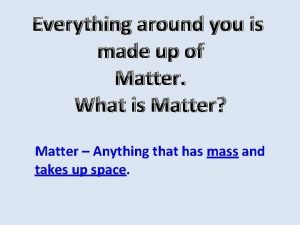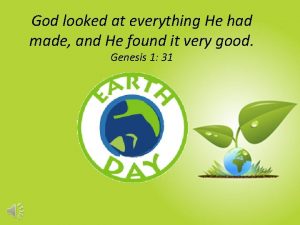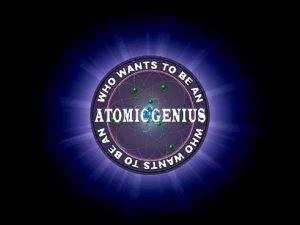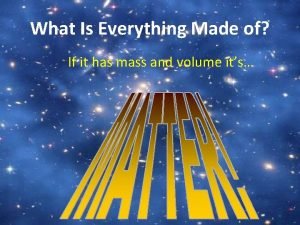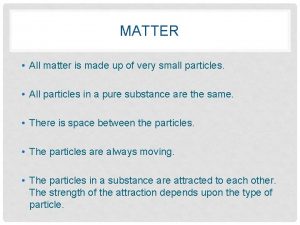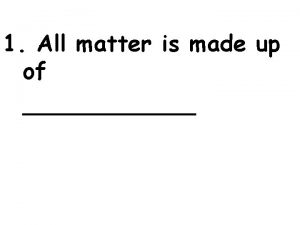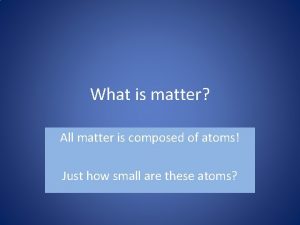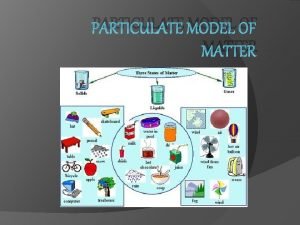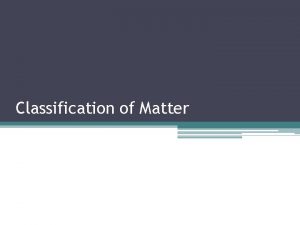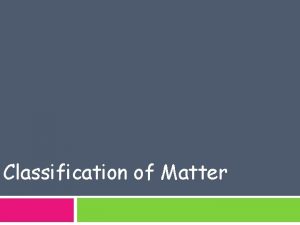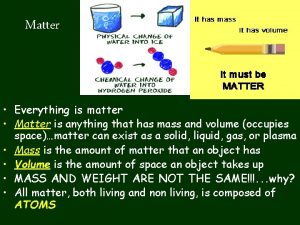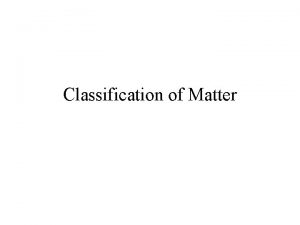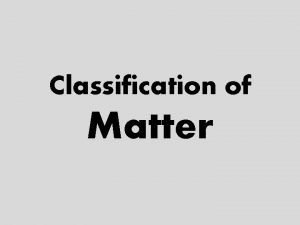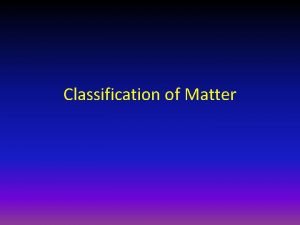Classification of Matter Matter Everything is made up
















- Slides: 16

Classification of Matter

Matter ö Everything is made up of tiny particles called atoms. ö We organize matter by how the atoms are connected (bonded)

2 major classifications categories ö 1. Pure Substance – made up of 1 kind of matter, from the periodic table ö 2. Mixture – made of 2 or more substances that are not chemically combined

1. Pure Substances A. Element w All matter composed of identical atoms, from the periodic table w EX: copper

A. Element 1. Monoatomic – 1 atom - EX: He 2. Diatomic – 2 atoms - EX: O 2 3. Polyatomic – 3 or more atoms - Ex: Al 3

B. Compound w 2 or more different elements that chemically combine to form a new substance w properties differ from those of individual elements w EX: salt (Na. Cl), H 2 O

2. Mixtures ö Material that contains 2 or more substances that are not chemically combined w Can physically separate w 2 Types: Homogeneous and Heterogeneous

A. Homogeneous ö Homogeneous Mixture (Solution) w even distribution of components w very small particles w particles never settle w Can’t filter out particles w EX: saline solution, Cofffee w/ sugar

Solutions ö In a solution you have a solute and a solvent ö Solvent - the liquid the substance dissolves in w Ex: water ö Solute - what dissolves w Ex: salt

B. Heterogeneous ö Heterogeneous Mixture w Materials are not evenly blended w 2 types: colloids and suspensions w EX: granite, pizza, dry soup mix

a. Colloid ö Colloid w medium-sized particles, can’t see them w particles never settle w Tyndall effect - particles scatter light (looks cloudy) w EX: milk

B. Suspension ö Suspension w large particles w particles scatter light w particles will settle out (needs to be shaken) w EX: vinaigrette dressing, muddy water, anything you have to shake

Tyndall Effect ö When light bends around particles in a mixture ö Used to tell is a mixture is homogeneous (solution) or heterogeneous (colloid or suspension) suspension ö EX: when sunlight comes through window


A. Matter Flowchart MATTER yes MIXTURE yes Is the composition uniform? Homogeneous Mixture (solution) no Can it be separated by physical means? PURE SUBSTANCE no Heterogeneous Mixture yes Can it be decomposed by chemical means? Compound no Element

Law of Conservation of Mass ö Matter is neither created or destroyed in a chemical change ö The mass of all substances before the reaction = mass after the reaction ö 2 H 2 O 2 2 H 2 O + O 2
 Everything around you is made up of
Everything around you is made up of God looked at everything he had made
God looked at everything he had made Everything surrounds us is called
Everything surrounds us is called Everything around you is made up of
Everything around you is made up of What is everything made of
What is everything made of God saw everything he made and it was good
God saw everything he made and it was good Hot air balloon
Hot air balloon Classification of matter section 1 composition of matter
Classification of matter section 1 composition of matter Composition of matter section 1
Composition of matter section 1 Composition of matter section 1
Composition of matter section 1 All matter is made up of
All matter is made up of Element mixture and compound diagram
Element mixture and compound diagram Whats gray matter
Whats gray matter All matter is made up of
All matter is made up of Matter is made up of
Matter is made up of Chapter 2 section 1 classifying matter answers
Chapter 2 section 1 classifying matter answers Gray matter and white matter
Gray matter and white matter
